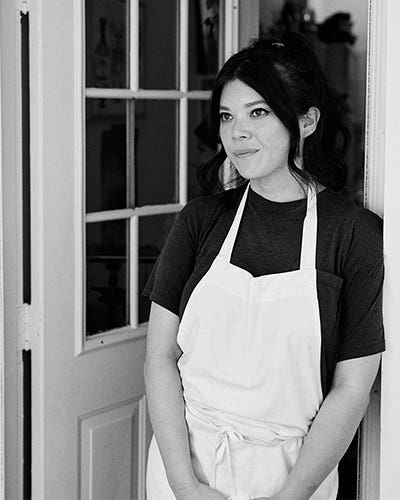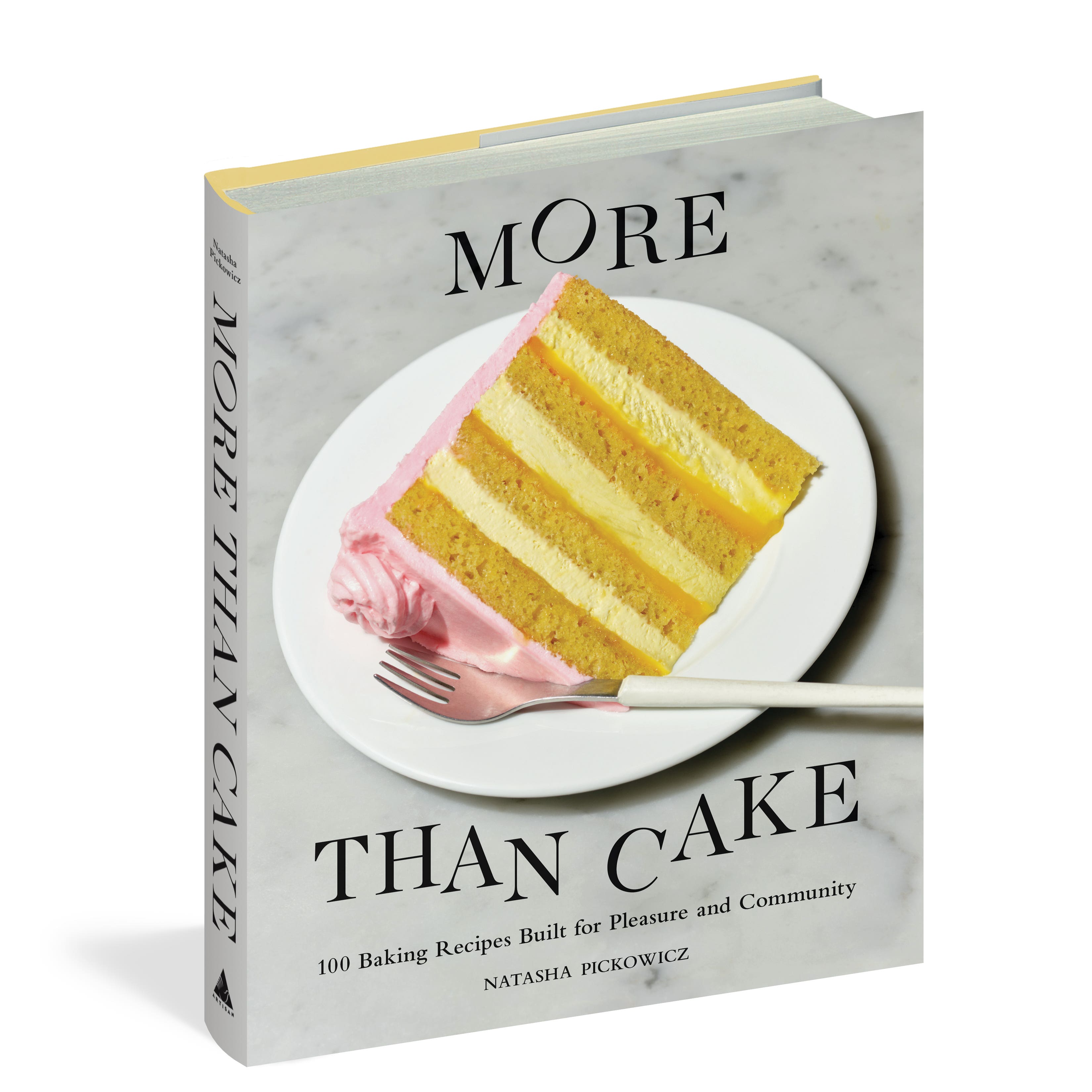Natasha Pickowicz's Toasted Vanilla Bean Pound Cake

Natasha Pickowicz's Toasted Vanilla Bean Pound Cake
This pound cake, with its sweet-and-salty crust and fragrant vanilla bean crumb, is extraordinary on its own, but individually toasted slices truly catapult it into your special-occasion repertoire.
| TYPE | DESSERT |
| SERVES | 8 |
| DIFFICULTY | EASY |
| PREP TIME | 20 MIN |
| COOK TIME | 5 HOURS |
Ingredients
- ¼ cup (60 g) turbinado sugar
- 1 vanilla bean
- 1¼ cups plus 2 tablespoons (280 g) granulated sugar
- 2½ cups (300 g) all-purpose flour
- ½ cup (60 g) corn flour
- ½ teaspoon baking soda
- 1 teaspoon kosher salt
- 10 ounces (285 g) unsalted butter, cubed, at room temperature
- 3 eggs (150 g), at room temperature (see tip #3)
- 1 teaspoon vanilla extract
- ¾ cup plus 2 tablespoons (190 g)
- buttermilk, at room temperature
- 2 tablespoons (30 g) fresh lemon juice
- Flaky sea salt
- Salted cultured butter
- Yogurt or jam, for serving (optional)
- Fresh fruit, for serving (optional)
Tip 1—A coating of cooking spray on the parchment will glue any number of crunchy toppings to the sides of your cake, creating an outrageously yummy crust. Small seeds like flax and sesame and crunchy sugars like turbinado add texture and visual interest.
Tip 2—Never throw away “spent” vanilla pods. You can steep them in simple syrup for poaching fruit or soaking cakes, or in vodka or bourbon to make your own vanilla extract. Vanilla beans are really expensive because they require so much time and energy to harvest and cure—so maximize their potential!
Tip 3—If you’ve forgotten to temper your eggs, fill a deep bowl with hot water, drop the eggs (still in their shells) right into the bowl, and leave them there until they feel room temperature in your palm. And, unless you live in a superhot and humid climate, you can leave your butter, eggs, and buttermilk out overnight, which is what I do when I want to get a jump-start on baking the next morning.
Directions
Elevating a pound cake from ordinary to sublime requires a careful hand and a few simple techniques. Controlling the temperature of your ingredients before you begin mixing is one key to a perfectly executed cake. A stand mixer will most efficiently beat air into the butter, so the final cake tastes delicate, not dense.
Your stand mixer has just spent 5 minutes creaming air into your cake, so use a superlight touch when incorporating the dry ingredients at the end. Overmixing is the easiest way to deflate a butter-based batter, leading to an unappetizing gummy texture. I radically undermix—you should see powdery streaks in your batter as you go—and then finish by hand.
Resist the urge to open your oven until at least halfway through your bake. The first 30 minutes of a “closed oven” are crucial for a dense cake batter to “jump,” giving it spring and lift. An open oven door can drop your oven temperature dramatically, which can lead to sad-looking cakes.
- Preheat the oven and prep the loaf pan. Position a rack in the center of the oven and preheat the oven to 350°F (175°C). Mist an 8-inch (20 cm) loaf pan with cooking spray. Drape a sheet of parchment inside, like a saddle, so that it comes up the long sides of the pan, and lightly mist the paper with cooking spray. Sprinkle 2 tablespoons of the turbinado sugar into the pan and shake the pan gently so that the sugar sticks to the sides of the parchment (see tip #1).
- Make the vanilla sugar. Use a small sharp knife to halve the vanilla bean lengthwise, pry open the two halves, and scrape the vanilla seeds out. Add the vanilla caviar and granulated sugar to the bowl and massage until damp and fragrant. (Don’t toss the vanilla pod; see tip #2.)
- Whisk together the dry ingredients. In a medium bowl, whisk together the all-purpose flour, corn flour, baking soda, and kosher salt; set aside.
- Cream the butter and vanilla sugar. In a stand mixer fitted with the paddle (or in a large bowl using a handheld mixer), cream the softened butter and vanilla sugar together on medium speed until fluffy and lightened in color (like frosting), 4 to 5 minutes.
- Add the eggs and extract. Drop in the eggs one at a time, beating after each addition and stopping to scrape the bowl with a spatula, 1 to 2 minutes total. Add the vanilla extract and paddle to combine.
- Alternate the dry and wet ingredients. With the mixer off, add half of the flour mixture to the mixer bowl. Turn the mixer on to the lowest speed and beat for 5 seconds (the mixture should still look very streaky and undermixed). Gently scrape the bottom of the bowl with a spatula. Add half of the buttermilk and half of the lemon juice. Turn the mixer back on to the lowest speed and beat for 3 to 4 seconds. Add the rest of the flour mixture and beat for 5 seconds. Finally, add the rest of the buttermilk and lemon juice, taking care to undermix. Turn off the mixer and finish combining the batter with a spatula by hand, using a light touch.
- Bake the loaf. Scrape the cake batter into the prepared loaf pan and smooth the surface evenly with the spatula. Sprinkle the remaining 2 tablespoons turbinado sugar on top. Scatter a pinch of flaky sea salt on the surface as well. Immediately transfer to the oven and bake until a cake tester inserted into the center of the loaf comes out clean, 60 to 70 minutes, rotating the pan front to back after 30 minutes. Begin to check for doneness at the 50-minute mark.
- Slice and toast. Lift the cake out of the pan and remove the parchment. You can eat the cake warm and untoasted, cut into 1-inch (2.5 cm) slices. Or cool the loaf completely, 3 to 4 hours. (The unsliced cake can be wrapped tightly and stored at room temperature for up to 5 days, or in the freezer for up to 1 month.) To toast the cake slices, heat a small nonstick or cast-iron skillet over medium heat and add 1 tablespoon (15 g) salted cultured butter. Add a slice of cake and toast until fragrant and hot, about 3 minutes on each side. Repeat with as many cake slices as you are serving, adding more salted butter as necessary. Serve warm, with spoonfuls of yogurt or jam or with fresh fruit.
Excerpted from More Than Cake by Annie Fenn (Artisan Books). Copyright © 2023.


RECIPE BY
Natasha Pickowicz
Natasha Pickowicz is a New York City–based chef and writer. She is a three-time James Beard Foundation Award finalist. Much of her pastry work explores the relationship between baking and social justice, including ongoing collaborations with seminal New York City institutions like Lenox Hill Neighborhood House, God’s Love We Deliver, the Brigid Alliance, and Planned Parenthood of Greater New York, for whom she produced a massive city-wide bake sale, raising more than $150,000 between 2017 and 2019. Currently, Pickowicz runs the pastry pop-up called Never Ending Taste, which has been held at NYC’s Superiority Burger, Brooklyn’s the Four Horsemen, the American-Vietnamese bakery Ba. n B., the Taiwanese tearoom T. Company, Los Angeles’s Kismet, and the legendary Chino Farm in Rancho Santa Fe, California. Pickowicz’s recipes and writing have been published in the New York Times, the Wall Street Journal, Bon App.tit, Saveur, Food & Wine, New York magazine, Cherry Bombe, and many other publications. Follow her on Instagram at @natashapickowicz





